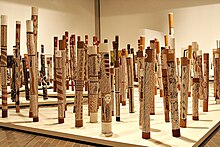Yolngu
The Yolngu (sometimes also referred to as Murngin) are an Aboriginal tribe in Australia . They inhabit the northeastern Arnhem Land (including the Gove Peninsula ) in the Northern Territory . The approximately 5000 Yolngu live mainly in Milingimbi , Ramingining , Gunyangara , Yirrkala , Gunbalanya and in other small homelands . About 800 Yolngu live in the largest settlement, Yirrkala.
history
For centuries, the Yolngu had contact with the Macassar fishermen who came to their coasts to catch trepang . The fishermen respected the Yolngu lands and traded with them. The Yolngu therefore had iron implements such as axes and knives. It was not until 1906 that the Australian government prohibited the Macassars from fishing off their coasts. The Yolngu also traded with the Aborigines from central Australia for millennia . For example, they didn't make boomerangs themselves , but bought them in barter from other Aborigines.
Centuries ago, the Yolngu came into contact with Dutch seafarers, after whom they all call the White Ballanda (Dutch) to this day.
In the 1930s, British colonization began in northwestern Arnhem Land and there were violent conflicts with the whites and Japanese, for example in the Caledon Bay crisis from 1932 to 1934.
When the Gove bauxite mine at Yirrkala was built without consulting the traditional owners in the early 1960s , the Yolngu brought the Yolngu Bark petition bilingual in the Australian Parliament. This petition attracted national and international attention. The petition was rejected by both parliament and the court. The Yolngu were defeated, but were able to reach an agreement with the mining company on the operation of the mine, which concerned a compensation payment and the consideration of their holy places. In May 2011, an agreement was reached between Rirratjingu, Gumatj and Galpu Traditional Owners , Northern Land Council and Rio Tinto Alcan for an additional 42 years of mining operations until 2053.
The public relations work of the Aboriginal rock band Yothu Yindi , to which some Yolngu belong, made an international audience aware of the problem of the disenfranchisement of the indigenous people and their fight against it.
language
The Yolngu speak a language they call Yolngu matha (tongue of the Yolngu). There are several dialects in this language.
Culture
In contrast to other Aboriginal tribes, the Yolngu came into contact with the whites late, so they were largely able to maintain their culture and way of life. Many members of the clans in Arnhem Land still live mainly from fishing, hunting bush animals and collecting bush food , albeit equipped with vehicles, motor boats and guns and alongside market economy activities. They maintain strong spiritual ties with their traditional country and the ethnic religion dominates the faith. Christian elements were woven into it.
They are known for their bark painting. Their art and cultural centers are for example in Milingimbi , Yirrkala and Ramingining. This Aboriginal tribe has produced numerous artists, such as Narritjin Maymuru , who participated with other artists of this people in the Yolngu Bark petition in the form of a bark painting in 1963.
Her didgeridoo builders, such as Djalu Gurruwiwi , and players such as Nicky Yunupingu († 2008) and Bunimburr Marika from Yothu Yindi are known in Australia.
Their annual Garma cultural festival is of great importance for their culture and the coexistence with other people .
The Yolngu know not four but six seasons.
Sepulchral culture
In the Yolngu sepulchral culture , the family and tribal authorities determine whether the name of a deceased person is mentioned and / or pictures are shown. This decision covers a period of months or years.
Kinship relationships
The life of the Yolngu is structured by a complex system of dual moiety that governs life, ceremonies and marriage.
For example, a Yirritja person can only marry one Dhuwa person and vice versa. Each item is assigned either one or the other moiety, as well as the country, language, totems and worldview.
| Moiety | Clans |
|---|---|
| Yirritja | Gumatj , Gupapuyngu, Wangurri, Ritharrngu, Mangalili, Munyuku, Madarrpa, Warramiri, Dhalwangu, Liyalanmirri |
| Dhuwa | Dhuwa Rirratjingu, Galpu, Djambarrpuyngu, Golumala, Marrakulu, Marrangu, Djapu, Datiwuy, Ngaymil, Djarrwark |
Personalities
- Dr. G. Yunupingu (1971–2017), musician, honorary doctor, nephew of Dr. M. Yunupingu
- Dr. M. Yunupingu (1956–2013), teacher, elder and bandleader of the Yothu Yindi, honorary doctorate
- David Malangi (1927–1998), elder and painter, honorary doctorate
- Gulumbu Yunupingu (1943–2012), painter and woman elder
See also
Individual evidence
- ↑ a b c ncl.net.au ( Memento of the original from July 20, 2013 in the Internet Archive ) Info: The archive link was inserted automatically and has not yet been checked. Please check the original and archive link according to the instructions and then remove this notice. : About Yolngu , accessed June 29, 2013
- ↑ riotintoalcan.com (PDF; 513 kB): Gove , in English, accessed on April 14, 2012
- ↑ Richard B. Lee and Richard Daly (Eds.): The Cambridge Encyclopedia of Hunters and Gatherers. 4th edition, Cambridge University Press, New York 2010 (first printed 1999), ISBN 978-0-521-60919-7 . Pp. 367-370.
- ↑ nga.gov.au (PDF; 1.7 MB): No ordernary Place: The art of David Malangi , in English, accessed on June 29, 2013
- ↑ blogs.crikey.com.au (Declaration by the Yunupingu family) : A message from his family on the use of the name & images of the late Mr Yunupingu , June 5, 2013, in English, accessed June 14 2013
